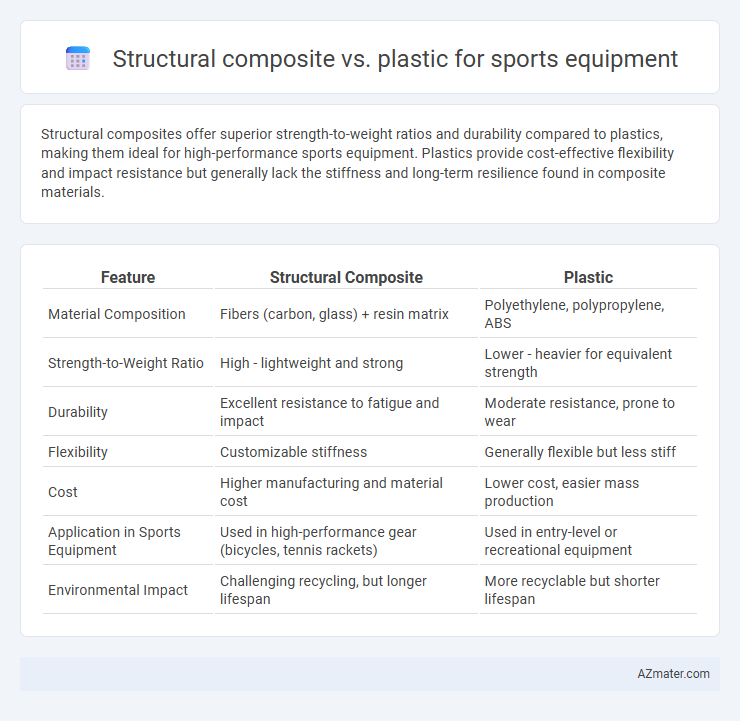Structural composites offer superior strength-to-weight ratios and durability compared to plastics, making them ideal for high-performance sports equipment. Plastics provide cost-effective flexibility and impact resistance but generally lack the stiffness and long-term resilience found in composite materials.
Table of Comparison
| Feature | Structural Composite | Plastic |
|---|---|---|
| Material Composition | Fibers (carbon, glass) + resin matrix | Polyethylene, polypropylene, ABS |
| Strength-to-Weight Ratio | High - lightweight and strong | Lower - heavier for equivalent strength |
| Durability | Excellent resistance to fatigue and impact | Moderate resistance, prone to wear |
| Flexibility | Customizable stiffness | Generally flexible but less stiff |
| Cost | Higher manufacturing and material cost | Lower cost, easier mass production |
| Application in Sports Equipment | Used in high-performance gear (bicycles, tennis rackets) | Used in entry-level or recreational equipment |
| Environmental Impact | Challenging recycling, but longer lifespan | More recyclable but shorter lifespan |
Introduction to Sports Equipment Materials
Structural composites offer superior strength-to-weight ratios and enhanced durability compared to traditional plastics, making them ideal for high-performance sports equipment such as tennis rackets and bicycle frames. Composite materials like carbon fiber-reinforced polymers provide excellent impact resistance and stiffness, which improve athlete performance and safety. In contrast, plastics such as polyethylene and polypropylene are cost-effective and lightweight but typically lack the mechanical strength required for professional-grade sports gear.
Overview of Structural Composites
Structural composites, consisting of fiber reinforcements like carbon or glass embedded in a polymer matrix, offer superior strength-to-weight ratios essential for high-performance sports equipment. These materials provide enhanced stiffness, impact resistance, and fatigue durability compared to traditional plastics, making them ideal for applications such as tennis rackets, bicycle frames, and protective gear. Advances in composite manufacturing techniques, including resin transfer molding and automated fiber placement, enable precise control over material properties and complex shapes, optimizing athlete performance and safety.
Understanding Plastics in Sports Equipment
Plastics in sports equipment offer lightweight durability and design flexibility, making them ideal for products like helmets, pads, and protective gear. Structural composites, combining plastics with fibers like carbon or fiberglass, provide enhanced strength-to-weight ratios critical for high-performance gear such as bicycles and racquets. Understanding the material properties of plastics, including impact resistance, elasticity, and thermal stability, is essential for optimizing functionality and safety in sports applications.
Comparative Strength and Durability
Structural composites such as carbon fiber and fiberglass offer superior strength-to-weight ratios and enhanced durability compared to traditional plastics, making them ideal for high-performance sports equipment like tennis rackets and bicycle frames. These composites resist fatigue, impact, and environmental degradation better than plastics, which tend to deform and wear out faster under repeated stress. The enhanced mechanical properties of structural composites translate to longer-lasting, more reliable equipment that maintains performance under rigorous conditions.
Weight and Performance Impact
Structural composite materials used in sports equipment offer superior strength-to-weight ratios compared to traditional plastics, resulting in lighter gear that enhances athlete agility and endurance. Composites like carbon fiber and fiberglass provide excellent stiffness and impact resistance, improving performance by maximizing energy transfer and reducing fatigue. Plastics, while more affordable, tend to be heavier and less rigid, which can compromise speed and control in high-performance sports applications.
Flexibility and Design Versatility
Structural composites offer superior flexibility and design versatility compared to traditional plastics in sports equipment, allowing for customized stiffness and impact resistance tailored to specific athletic needs. The layered construction of composites enables complex shapes and lightweight designs that enhance performance and durability. In contrast, plastics often lack the mechanical tunability and structural strength needed for high-performance sports applications, limiting design innovation.
Cost Analysis: Composites vs Plastics
Structural composites, while offering superior strength-to-weight ratios and enhanced durability for sports equipment, typically incur higher manufacturing and material costs compared to plastics. Plastics provide cost-effective mass production benefits, making them a popular choice for budget-friendly sports gear, though they may compromise on performance and longevity. The cost analysis favors composites for high-performance applications due to their long-term value, despite the initial investment being substantially greater than that of plastics.
Environmental Sustainability Considerations
Structural composites for sports equipment offer superior strength-to-weight ratios and durability, resulting in longer product lifespans and reduced material consumption over time, which directly supports environmental sustainability. In contrast, conventional plastics, often derived from petrochemicals, tend to have shorter lifespans and contribute significantly to plastic pollution due to limited recyclability and degradation challenges. Incorporating bio-based or recyclable composites can further enhance environmental benefits by minimizing carbon footprints and promoting circular economy principles within the sports equipment industry.
Safety and User Experience
Structural composites in sports equipment offer superior impact resistance and enhanced durability compared to traditional plastics, significantly improving athlete safety during high-intensity activities. Their lightweight nature and customizable stiffness provide better shock absorption and ergonomic support, resulting in greater comfort and reduced fatigue. Plastics may be more affordable but often lack the advanced mechanical properties needed for optimal protection and long-term user satisfaction.
Future Trends in Sports Equipment Materials
Structural composites, such as carbon fiber reinforced polymers, offer superior strength-to-weight ratios and enhanced durability compared to traditional plastics, driving their increasing adoption in high-performance sports equipment. Future trends emphasize lightweight, sustainable composites incorporating bio-based resins and recycled fibers to reduce environmental impact while maintaining mechanical integrity. Innovations in nanomaterials and additive manufacturing are expected to further optimize the performance, customization, and cost-efficiency of sports gear made from structural composites.

Infographic: Structural composite vs Plastic for Sports equipment
 azmater.com
azmater.com